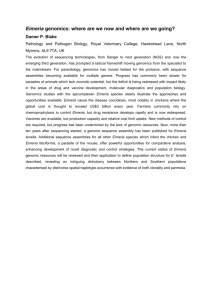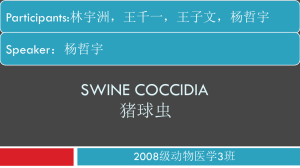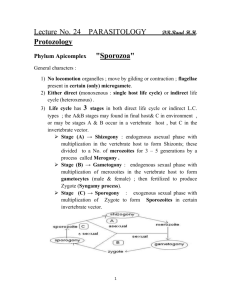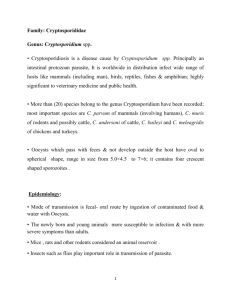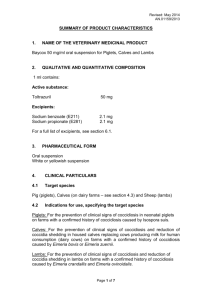livestock infections
advertisement
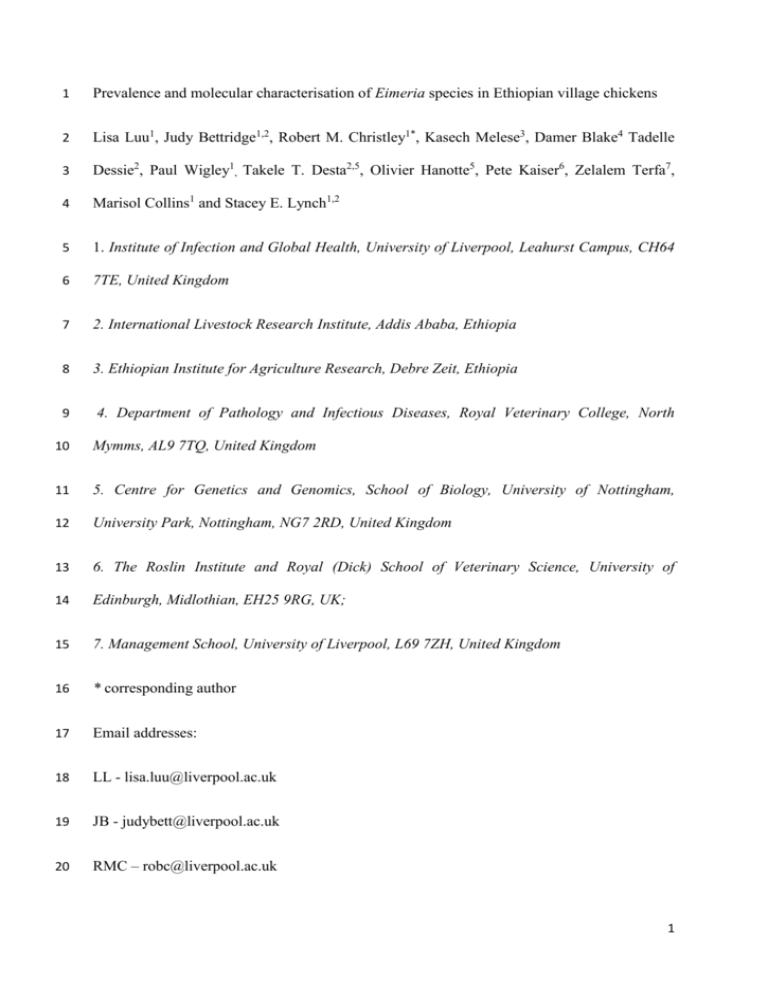
1 Prevalence and molecular characterisation of Eimeria species in Ethiopian village chickens 2 Lisa Luu1, Judy Bettridge1,2, Robert M. Christley1*, Kasech Melese3, Damer Blake4 Tadelle 3 Dessie2, Paul Wigley1, Takele T. Desta2,5, Olivier Hanotte5, Pete Kaiser6, Zelalem Terfa7, 4 Marisol Collins1 and Stacey E. Lynch1,2 5 1. Institute of Infection and Global Health, University of Liverpool, Leahurst Campus, CH64 6 7TE, United Kingdom 7 2. International Livestock Research Institute, Addis Ababa, Ethiopia 8 3. Ethiopian Institute for Agriculture Research, Debre Zeit, Ethiopia 9 4. Department of Pathology and Infectious Diseases, Royal Veterinary College, North 10 Mymms, AL9 7TQ, United Kingdom 11 5. Centre for Genetics and Genomics, School of Biology, University of Nottingham, 12 University Park, Nottingham, NG7 2RD, United Kingdom 13 6. The Roslin Institute and Royal (Dick) School of Veterinary Science, University of 14 Edinburgh, Midlothian, EH25 9RG, UK; 15 7. Management School, University of Liverpool, L69 7ZH, United Kingdom 16 * corresponding author 17 Email addresses: 18 LL - lisa.luu@liverpool.ac.uk 19 JB - judybett@liverpool.ac.uk 20 RMC – robc@liverpool.ac.uk 1 21 KM - kasechmelese@yahoo.com 22 DB - dblake@rvc.ac.uk 23 TD - T.DESSIE@CGIAR.ORG 24 PW - wigley@liverpool.ac.uk 25 TTD - takele_taye@yahoo.com 26 OH - Olivier.Hanotte@nottingham.ac.uk 27 PK - pete.kaiser@roslin.ed.ac.uk 28 ZT - zedgutu@gmail.com 29 MC - maricollins76@hotmail.com 30 SEL - stace.lynch@gmail.com 31 32 Corresponding author: Rob Christley 33 Telephone: +44 151 7946170 34 Fax: +44 151 7946028 35 Email: Robc@liverpool.ac.uk 36 2 37 Abstract 38 Background: Coccidiosis, caused by species of the apicomplexan parasite Eimeria, is a 39 major disease of chickens. Eimeria species are present world-wide, and are ubiquitous under 40 intensive farming methods. However, prevalence of Eimeria species is not uniform across 41 production systems. In developing countries such as Ethiopia, a high proportion of chicken 42 production occurs on rural smallholdings (i.e. ‘village chicken production’) where infectious 43 diseases constrain productivity and surveillance is low. Coccidiosis is reported to be 44 prevalent in these areas. However, a reliance on oocyst morphology to determine the 45 infecting species may impede accurate diagnosis. Here, we used cross-sectional and 46 longitudinal studies to investigate the prevalence of Eimeria oocyst shedding at two rural 47 sites in the Ethiopian highlands. 48 Results: Faecal samples were collected from 767 randomly selected chickens in May or 49 October 2011. In addition, 110 chickens were sampled in both May and October. Eimeria 50 oocysts were detected microscopically in 427 (56%, 95% confidence interval (95% CI) 52- 51 59%) of the 767 faecal samples tested. Moderate clustering of positive birds was detected 52 within households, perhaps suggesting common risk factors or exposure pathways. Seven 53 species of Eimeria were detected by real time PCR in a subset of samples further analysed, 54 with the prevalence of some species varying by region. Co-infections were common; 64% 55 (23/36, 95% CI 46-79%) of positive samples contained more than one Eimeria spp. Despite 56 frequent infection and co-infection overt clinical disease was not reported. Eimeria oocysts 57 were detected significantly more frequently in October (248/384, 65%, 95% CI 60-69%), 58 following the main rainy season, compared to May (179/383, 47%, 95% CI 42-52%, 59 p<0.001). Eimeria oocyst positivity in May did not significantly affect the likelihood of 60 detecting Eimeria oocyst five months later perhaps suggesting infection with different species 61 or immunologically distinct strains. 3 62 Conclusions: Eimeria spp oocysts may be frequently detected in faecal samples from village 63 chickens in Ethiopia. Co-infection with multiple Eimeria spp was common and almost half of 64 Eimeria positive birds had at least one highly pathogenic species detected. Despite this, all 65 sampled birds were free of overt disease. Although there was no evidence of a difference in 66 the prevalence of oocysts in faecal samples between study regions, there was evidence of 67 variation in the prevalence of some species, perhaps suggesting regional differences in 68 exposure to risk factors associated with the birds, their management and/or location-specific 69 environmental and ecological factors. 70 Keywords: Eimeria, Coccidiosis, Village Chickens, Ethiopia, molecular characterisation 71 72 4 73 Background 74 Indigenous chickens kept under village, scavenging production systems represent 97% of the 75 chickens farmed in Ethiopia [1]. 76 diseases, combined with limited extension and veterinary services, are major constraints to 77 village chicken production. Poor management and limited resources hinder the development 78 of chicken production by reducing outputs and by predisposing to disease outbreaks [2-4]. 79 Coccidiosis, caused by species of the apicomplexan parasite Eimeria, is a major cause of 80 mortality and morbidity in chickens worldwide, but clinical manifestations are not uniform 81 across production systems. Endemic infections and long term exposure without treatment in 82 broiler production systems can result in reduced feed conversion efficiency and growth rate, 83 and in extreme cases lead to tissue damage in the intestinal tract, promoting secondary 84 infections with opportunistic pathogens [5, 6]. 85 Coccidiosis is reported to be a major disease impacting Ethiopian village chickens [7, 8]. 86 Eimeria oocysts have been detected in up to 61% [8] of faecal samples collected from 87 indigenous village chickens in central Ethiopia, with six of the seven valid Eimeria species 88 known to infect the chicken identified by microscopy [7-9]. However, the advent of 89 molecular techniques has demonstrated that microscopy and post mortem identification of 90 Eimeria parasites can lead to incorrect identification of parasites [10, 11]. The correct 91 speciation of parasites is important due to the immunological and pathogenic variation across 92 the genus [10-12]. Microscopy was therefore carried out to determine the prevalence of 93 Eimeria genus parasites in indigenous village chickens in two regions of Ethiopia, 94 complimented by molecular characterisation to identify the Eimeria species circulating. In this system, micro- and macro-parasitic infectious 95 5 96 Results and Discussion 97 Detection of Eimeria oocysts in faecal material 98 Of the 767 faecal samples examined microscopically, Eimeria oocysts were detected in 427 99 (56%: 95% confidence interval (95% CI) 52-59%). The prevalence reported in this study is 100 comparable to the 42.2% (95% CI 31-55%: our calculation) previously reported in Ethiopian 101 highland areas [7]. The detection of Eimeria oocysts was significantly higher in October 102 (248/384, 65%, 95% CI 60-69%) compared to May (179/383, 47%, 95% CI 42-52%; chi- 103 square p-value <0.001). No significant differences were found in prevalence at region or 104 village levels. All faecal samples detected positive for Eimeria oocysts were collected from 105 chickens with no overt signs of clinical diseases. As birds were randomly selected from 106 within the household flock and presence of clinical disease was not a criterion for bird 107 selection, the absence of overt disease in our sample suggests that the prevalence of clinical 108 coccidiosis is rare compared to the prevalence of Eimeria carriage. Furthermore, the high 109 prevalence of oocyst shedding detected in apparently healthy birds is strong evidence that the 110 detection of oocysts alone in chicken faecal samples should not lead to a definitive diagnosis 111 of coccidiosis. Quantitative identification to the species level is clearly required to account 112 for species-specific pathogenicity. 113 There was evidence of moderate clustering of oocyst positivity in faecal samples collected 114 from chickens within a single family-flock. Estimates of intraclass clustering coefficient 115 (ICC) for household indicated 18.3% (using binary linearization method) or 13.4% (using the 116 latent-variable method) of the variation in the presence/absence of oocysts is due to variation 117 within households. 118 contagious” infections by Otte & Gumm [13], such as Newcastle disease (ICC 18%), but are 119 lower than those for other “highly contagious” infections, including infectious bursal disease These values are consistent with those reported for some “highly 6 120 (37%) and bovine viral diarrhoea (23% to 42%). Interestingly, they are somewhat similar to 121 the ICC values reported for Eimeria spp in cattle (18% to 30%). Hence, the ICC estimates in 122 this study suggest that although the bulk of the variation in detection of oocysts occurs 123 because of variation within birds, evidence of clustering of positive birds within households may 124 suggest a role for exposure to particular risk factors for birds within household flocks – identification 125 of these may suggest useful targets for control interventions. Further analysis found no evidence of 126 clustering at higher spatial scales (i.e. village or region). However, molecular characterisation 127 revealed species-level variation between regions (see below). Hence, while there was no 128 evidence of a difference in the prevalence of oocysts in faecal samples between regions, there 129 was evidence of variation in the prevalence of some species, perhaps suggesting regional 130 differences in exposure to in risk factors associated with the birds, their management and/or 131 location-specific environmental and ecological factors. 132 In addition to the repeat cross sectional study, faecal samples were collected from 110 133 chickens during both sampling periods. Eimeria oocysts were detected in the faeces of 32 134 (29%: 95% CI 21-39%) chickens at both time points, 63 (57%, 95% CI 47-67%) at one time 135 point (23 were found positive only in May, whereas 40 were positive only in October) and 15 136 (14%; 95% CI 8-22%) at neither of the time points. This finding is consistent with prolonged 137 sub-clinical re-infection (with the same or different species, or immunogically distinct 138 strains) in almost one-third of the birds. Within this subset of samples, the prevalence of 139 Eimeria oocysts was greater following the wet season in October (72/110, 65%, 95% CI 56- 140 74%) compared to May (55/110, 50%, 95% CI 41-59%; McNemar chi-square p-value = 0.04) 141 and this is in line with similar observations described for Eimeria in commercial chickens in 142 Pakistan [14]. The prevalence of Eimeria oocysts in this subset in October was not 143 significantly different to that of the randomly selected birds at the same time (chi square p- 144 value = 0.7). The prevalence of Eimeria oocysts in the October sample for birds that were 7 145 negative in May was 73% (40/55; 95% CI 59-83%) compared to 58% (32/55; 95% CI 44- 146 71%) for birds detected positive in May. However, this difference was not statistically 147 significant (Chi square p-value = 0.2). This may imply that previous detection of oocysts 148 does not impact the likelihood of detecting oocysts five months later, perhaps suggesting 149 infection with different species or immunologically distinct strains. 150 Molecular characterisation of circulating Eimeria species 151 Eimerian genomic DNA was detected in 47 of the 56 samples tested (Horro 22/26 and Jarso 152 25/30). Seven species of Eimeria were detected (Table 1). Regional comparisons show 153 differences in the predominant circulating species; Emeria praecox was found in 95% (21/22, 154 95% CI 75-99%) of samples tested from Horro and E. maxima was found in 60% (15/25, 155 95% CI 39-78%) of samples tested from Jarso. Eimeria praecox is widely considered to be 156 among the least pathogenic Eimeria species that infect the chicken, although recent reports of 157 a pathogenic isolate illustrates the risk posed by such a high prevalence of this species [15]. 158 The high prevalence of E. maxima in Jarso may be relevant to the birds found to be positive 159 on both sampling occasions since, while highly immunogenic, this species is commonly 160 characterised by strain-specific immunogenicity [16]. There is evidence in the data to support 161 this hypothesis; previous infection (as detected by faecal microscopy) appeared to have no 162 protective effect in Jarso, with prevalence in October of 65% (45-80%) among birds negative 163 in May compared to 58% (39-74%) for those positive in May (chi square p-value = 0.8). 164 Whilst still not statistically significant, there was some evidence of a greater effect of past 165 infection in Horro, where E. praecox predominated, with a prevalence in October of 83% 166 (62-95%) among birds negative in May compare to 59% (37-79%) for those positive in May 167 (chi square p = 0.1). Eimeria mitis was only found in samples collected from Jarso (28%, 168 7/25, 95% CI 14-48%). 169 pathogenic were not the most frequently isolated species (i.e. E. tenella, E. necatrix and E. Although the haemorrhagic species considered to be highly 8 170 brunetti [17]), highly pathogenic species were detected in almost half of all samples (20/47, 171 43%, 95% CI 29-58%). 172 Of the 47 samples where Eimeria oocysts were detected, 36 were known to be collected from 173 individual birds, the rest included fresh chicken faeces sampled from the environment and 174 may have included faeces from more than one bird. Of these 36 samples, more than one 175 Eimeria spp was detected in 64% (23/36, 95% CI 46-79%). Species frequencies in co- 176 infection are presented in Table 1. Eimeria praecox was the most common species and 177 detected in 46% of single infections and 74% of co-infections in this study. The frequency of 178 species presence in mixed infections was strongly correlated with overall prevalence of that 179 species (Spearman r=0.82, p=0.03) suggesting that there was no species predilection for co- 180 infection, except that due to prevalence. There was evidence for spatial clustering of patterns 181 of co-infection within each of the two study regions (Figure 1), however, this was less 182 obvious when E. mitis and E. praecox were excluded from the analysis (data not shown), 183 suggesting much of the spatial variation in patterns of co-occurrence was due to the different 184 prevalence of E. mitis and E. praecox between the two regions. 185 In this study, the isolation of Eimeria oocysts was not associated with overt clinical disease. 186 However, Eimeria species with a high pathogenic potential (e.g. E. tenella, E. necatrix, E. 187 brunetti [17] were detected. The circulation of pathogenic Eimeria species may significantly 188 contribute to high mortality in chickens less than eight weeks of age [17]. The mortality rate 189 among young birds is high in Ethiopian village production systems (estimated at around 60% 190 [3]) but the role of Eimeria species in this mortality is yet to be determined. Furthermore, 191 where additional contributory factors co-occur, such as malnutrition or co-infection with 192 other pathogens, even low oocyst infections may cause significant disease (e.g. co-infection 193 with Clostridium perfringens, causing Necrotic Enteritis). Although several Eimeria control 194 measures, such as vaccines and anti-coccidial drugs, are available in developing countries, 9 195 these may not be suitable for low-input rural poultry production systems. Changes in the 196 management of poultry and improved nutrition are, however, recognised as economical and 197 effective ways to reduce the adverse effects of non-viral diseases. The birds in this study 198 were kept in a variety of ways, but the majority were housed either within the family 199 dwelling or the kitchen building at night, where they would perch on the rafters or partitions, 200 or on the floor. Purpose-built housing or perches were rarely seen, although most households 201 provided a nest box for hens with chicks. Removal of faeces was done as part of daily 202 household cleaning, and these were used by some households for crop fertiliser. Practical 203 ways to reduce disease transmission could include improving hygiene measures such as 204 prevention of overcrowding, disposal of sick and dead birds and regular removal of excreta, 205 provision of improved housing with elevated perches for adult birds and separate overnight 206 shelter and feed provision for chicks from older birds [18, 19]. 207 208 Conclusion 209 In conclusion, Eimeria spp oocysts may be frequently detected in faecal samples from village 210 chickens in Ethiopia in the absence of overt clinical signs. Furthermore, while there was no 211 evidence of a difference in the prevalence of oocysts in faecal samples between regions, there 212 was evidence of variation in the prevalence of some species, perhaps suggesting differences 213 in risk factors associated with the birds, their management and/or location-specific 214 environmental and ecological factors. Importantly, we identified Eimeria species that have 215 high pathogenic potential circulating in apparently healthy adult Ethiopian indigenous village 216 chickens. Further investigation of the role of Eimeria spp in both clinical disease and 217 subclinical effects on production are required to better understand their impact and whether 218 interventions to reduce the burden of these organisms in village poultry may offer benefits, or 219 even impact negatively by disrupting endemic stability. 10 220 221 Materials and Methods 222 Ethics statement 223 This study was approved by the University of Liverpool Committee on Research Ethics 224 (reference RETH000410). Participants were provided with verbal information to inform them 225 of the purpose of the study, that participation was entirely voluntary, that they were free to 226 leave the study at any time and that all data would be kept securely. Verbal informed consent 227 was obtained prior to collection of data and samples. Verbal information and verbal informed 228 consent was deemed appropriate due to the expected high illiteracy rate among participants, 229 many of whom would therefore be unable to understand written information or consent forms 230 and who may be unable provide a written consent. The consent procedure was approved by 231 the University of Liverpool Committee on Research Ethics and documented for each 232 participant by a tick box on the information sheet that was read to each potential participant 233 and which was ticked in the presence of the participant. 234 Sample collection 235 Two highland regions were selected for this study; Horro district (Western Ethiopia, villages 236 surrounding Shambu located at 9°34′N 37°06′E with elevations ranging from 2255 to 2613 237 meters above sea level and Jarso district (Eastern Ethiopia, villages surrounding Ejersa Goro 238 located at 9°29′N 42°14′E with elevations ranging 1993 to 2719 meters above sea level. 239 Poultry production in the study areas predominantly used local ecotypes and is based on a 240 free-ranging scavenging system. The median flock size in Horro was 8 (interquartile range 241 4.0 to 14.5) and in Jarso was 4 (2.75 to 6.0). The birds were kept for sale (of birds and eggs), 242 occasional home consumption and for socio-cultural purposes. Within each region, two pairs 11 243 of neighbouring villages were selected for sampling, based on their willingness to participate, 244 and on knowing there was no recent flock improvement programme in the area; and in each 245 village 25 households were randomly selected from lists of households maintained by local 246 agricultural offices. Faecal samples were collected from two randomly-selected birds within 247 each household. Only birds estimated to be greater than 6 months of age and of the local 248 ecotype, based on owner reporting and physical examination, were eligible for inclusion in 249 the study. 250 Faecal samples were collected from study sites in May 2011 (n=383) and October 2011 251 (n=384), months flanking the main Ethiopian rainy season between July and September. 252 Where possible, birds sampled in May were also resampled in October, resulting 110 253 additional samples in October. The identities of the resampled chickens were confirmed by 254 comparing a series of photographs (resolution of 96 dpi or greater), including lateral, dorsal 255 and frontal views of the bird and close-up views of the head and feet, taken on both 256 occasions. 257 Microscopic detection of Eimeria oocysts 258 Concentration McMaster salt flotation technique was used to determine the prevalence of 259 Eimeria genus parasites within the study chicken population [20]. 260 Molecular characterisation of Eimeria oocysts 261 To determine the species of Eimeria circulating at these two sites, positive samples were 262 randomly selected for further molecular analysis. Oocysts were isolated [21] from between 263 0.60grams and 17.09 grams of faecal matter; DNA was extracted using a Qiagen QIAmp 264 stool extraction kit according to the manufactures instructions. Extracted DNA samples were 265 tested by real time PCR, as described by Vrba et al. [22]. 12 266 Statistical analysis 267 The proportion of samples found positive (by microscopy) in each region and village, and at 268 each sampling round were initially compared using chi square tests. Subsequently, multilevel 269 binary logistic regression models were constructed with the outcome defined as positive or 270 negative based on microscopy and individual birds as level 1 and households as level 2. 271 Intercept only models were used to estimate the proportion of variation due to the household 272 level by calculating the intraclass clustering coefficient (ICC) using two methods: binary 273 linearization and the latent-variable method [23]. For the birds which underwent repeat 274 sampling, McNemar’s test was used to compare the proportions positive at each time point, 275 chi square tests were used to compare the proportions positive in October among birds that 276 were either positive or negative at the May sampling and Fisher’s exact test was used to 277 compare the frequency of each species between the two study regions. 278 For each Eimeria species, the frequency of presence in mixed infections was compared to its 279 overall prevalence using Spearman rank-order correlation. Co-occurrence of Eimeria species 280 was evaluated using cluster analysis using the Manhattan distance measure and McQuitty 281 agglomeration method. All statistical analyses were performed using R (http://www.R- 282 project.org/) 283 List of abbreviations 284 CI – confidence interval 285 ICC – intraclass clustering coefficient 286 PCR – polymerase chain reaction 287 13 288 Competing interests: The authors declare that they have no competing interests 289 290 Authors’ contributions 291 LL, RMC and SEL designed the study, analysed and interpreted the data and wrote the 292 manuscript. LL, JB, TD, DB, ZT, KM, MC and SEL assisted with fieldwork and/or 293 laboratory analysis. LL, JB, RMC, DB, TD, PW, TTD, OH, PK, ZT, MC and SEL helped 294 draft and review the manuscript and contributed intellectually to the development of the 295 research. 296 Acknowledgements 297 We thank Biotechnology and Biological Sciences Research Council (BBSRC), the UK 298 Department for International Development (DFID) and the Scottish Government for 299 providing funding for the ‘Reducing the impact of infectious disease on poultry production in 300 Ethiopia’ project under the Combating Infectious Diseases of Livestock for International 301 Development (CIDLID) programme (BB/H009396/1, BB/H009159/1 and BB/H009051/1). 302 LL was funded through a BBSRC Masters Training Grant (BB/H020829/1). We thank the 303 Chicken Health for Development project team members and the farmers and development 304 agents in the Jarso and Horro districts for their assistance. 305 14 306 References 307 308 309 310 311 312 313 314 315 316 317 318 319 320 321 322 323 324 325 326 327 328 329 330 331 332 333 334 335 336 337 338 339 340 341 342 343 344 345 346 347 348 349 350 351 352 353 354 1. 2. 3. 4. 5. 6. 7. 8. 9. 10. 11. 12. 13. 14. 15. 16. 17. 18. 19. 20. CSA: Report on livestock and livestock characteristics (Private peasant holdings). In. Addis Ababa: Central Statistical Agency; 2010/11. Dinka H, Chala R, Dawo F, Bekana E, Leta S: Major constraints and health management of village poultry production in Rift Valley of Oromia, Ethiopia. . American-Eurasian Journal of Agriculture and Environmental Science 2010, 9:529-533. Duguma R: Understanding the role of indigenous chickens during the long walk to food security in Ethiopia. In: Livestock Research for Rural Development vol. 21; 2009. Halima H, Neser FWC, Marle-Koster E, Kock A: Village-based indigenous chicken production system in north-west Ethiopia. Tropical animal health and production 2007, 39(3):189-197. Van Immerseel F, De Buck J, Pasmans F, Huyghebaert G, Haesebrouck F, Ducatelle R: Clostridium perfringens in poultry, an emerging threat for animal and public health. . Avian Pathology 2004, 33:537-549. Yegani M, Korver DR: Factors affecting intestinal health in poultry. Poultry Science 2008, 87:2052-2063. Ashenafi H, Tadesse D, Medhin G, Tibbo M: Study on coccidiosis of scavenging indigenous chickens in central Ethiopia. Tropical animal health and production 2004, 35:693-701. Gari G, Tilahun G, Dorchies P: Study on poultry coccidiosis in Tiyo district, Arsi zone, Ethiopia. International Journal of Poultry Science 2008, 7:251-256. Lobago F, Worku N, Wossene A: Study on coccidiosis in Kombolcha Poultry Farm, Ethiopia. . Tropical Animal Health and Production 2005, 37:245-251. Haug A, Gjevre A, Thebo P, Mattsson JG, Kaldhusdal M: Coccidial infections in commercial broilers, epidemiological aspects and comparisons of eimeria species identification by morphometric and polymerase chain reaction techniques. Avian Pathology 2008, 37:161170. Sun XM, Pang W, Jia T, Yan WC, He G, Hao LL, Bentue M, Suo X: Prevalence of Eimeria species in broilers with subclinical signs from fifty farms. . Avian Diseases 2009, 53:301-305. Schnitzler BE, Shirley MW: Immunological aspects of infections with Eimeria maxima: A Short Review. Avian Pathology 1999, 28:537-543. Otte MJ, Gumm ID: Intra-cluster correlation coefficients of 20 infections calculated from the results of cluster-sample surveys. Preventive Veterinary Medicine 1997, 31:147-150. Awais MM, Akhtar M, Iqbal Z, Muhammad F, Anwar MI: Seasonal prevalence of coccidiosis in industrial broiler chickens in Faisalabad, Punjab, Pakistan. Tropical animal health and production 2012, 44:323-328. Williams RB, Marshall RN, Pages M, M. D, del Cacho E: Pathogenesis of Eimeria praecox in chickens: virulence of field strains compared with laboratory strains of E. praecox and Eimeria acervulina. Avian Pathology 2009, 38:359-366. McDonald V, Shirley MW, Bellatti MA: Eimeria maxima: characteristics of attenuated lines obtained by selection for precocious development in the chicken. Experimental Parasitology 1986, 61:192-200. McDougald LR: Coccidiosis. In: Diseases of Poultry 11th edn. Edited by Saif YM, Barnes J, Glisson JR, Fadly AM, McDougald LR, Swayne DE. Ames: Iowa State Press; 2003: 1001–1010. Sonaiya EB, Swan SEJ: Small-scale poultry production technical guide. Rome: Food and Agriculture Organization of the United Nations; 2004. Ahlers C, Alders, R., Bagnol, B.,, Cambaza AB, Harun, M., Mgomezulu, R.,, Msami H, . Pym, R., Wegener, P., Wethli, E.,, Young M: Improving village chicken production: a manual for fieldworkers and trainers. Canberra: ACIAR Monograph No. 139. ; 2009. Permin A, Hansen JW: Epidemiology, Diagnosis and Disease Control of Poultry Parasites. . Rome: Food and Agriculture Organization of the United Nations; 1998. 15 355 356 357 358 359 360 361 21. 22. 23. Long PL, Millard BJ, Joyner LP, Norton CC: A guide to laboratory techniques used in the study and diagnosis of avian coccidiosis. Folia Veterinaria Latina 1976, 6:201–217. Vrba V, Blake DP, Poplstein M: Quantitative real-time PCR assays for detection and quantification of all seven Eimeria species that infect the chicken. Veterinary Parasitology 2010, 174:183-190. Goldstein H, Browne W, Rasbash J: Partitioning variation in multilevel models. Understanding Statistics 2002, 1:223-231. 362 363 364 Figure 1 Co-occurrence of Eimeria spp. Faecal samples were collected from 47 chickens 365 from two regions of Ethiopia in May 2011. Each row represents one sample. Red boxes 366 indicated samples from Horro, blue indicate samples from Jarso. Light and dark shading 367 indicates each of the pairs of villages within each region. 368 16 369 Table 1. Frequency of detection of Eimeria species in chicken faecal samples. Samples 370 were collected from 47 indigenous chicken faecal samples in two regions of Ethiopia (Horro 371 and Jarso). The frequency of detection of multiple and single Eimeria species infections 372 among 36 of these 47 which were each known to come from a single bird are also presented. (n=22) (n=25) Mixed Fisher’s exact species infection p-value (n=23) E. acervulina 9 (40%) 10 (40%) 0.8 12 (52%) 1 (8%) E. brunetti 1 4 (18%) 5 (20%) 0.9 5 (22%) 0 (0%) E. maxima 5 (22%) 15 (60%) 0.022 13 (57%) 4 (31%) E. mitis 0 (0%) 7 (28%) 0.012 2 (9%) 2 (15%) E. necatrix 1 4 (18%) 2 (8%) 0.4 4 (17%) 0 (0%) E. praecox 21 (95%) 9 (36%) <0.0012 17 (74%) 6 (46%) E. tenella 1 3 (12%) 7 (28%) 0.3 3 (13%) 0 (0%) Species Horro Region Jarso 373 1. Considered to be highly pathogenic [17] 374 2. Significantly different (p <0.05) Single species infection (n=13) 375 376 377 378 17
